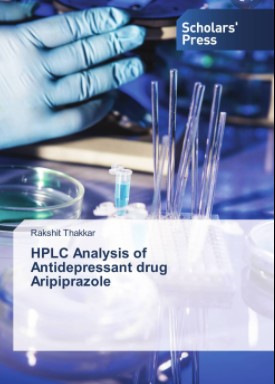
The active substance is Aripiprazole, an established active substance described in the European Pharmacopoeia (Ph.Eur.). Aripiprazole is a white or almost white powder and practically insoluble in water. Aripiprazole does not exhibit optical isomerism. The substance shows polymorphism and is manufactured as polymorphic.
Aripiprazole Raw Material Testing Procedure is used for both manufacturers of the active substance. The main objective of the ASMF procedure, commonly known as the European Drug Master File (EDMF) procedure, is to allow valuable confidential intellectual property.
ARIPIPRAZOLE RAW MATERIAL STANDARD
ANALYTICAL PROCEDURE
REFRENCE: USP 44, NF 39
APPROVAL BLOCK
| Title | Designation | Signature/Date |
| Written By: | Quality Control Analyst | |
| Reviewed By: | Quality Control Manager | |
| Verified By: | Quality Assurance In-charge | |
| Approved By: | Technical Operation Director |
Distribution List
| Sr. # | Department | New revision # | Retrieval Revision # | Signature & Date |
| 1 | ||||
| 2 |
DOCUMENT REVISION CONTROL
| Rev. # | Date | Initiated By | Page # | Nature of Amendment | Done By |
| 1 | |||||
| 2 |
Aripiprazole Raw Material Testing Procedure
1.0 PURPOSE:
To describes the procedure for testing of raw material Aripiprazole.
2.0 SCOPE:
This document describes the basic principles, defines the responsibilities and lays down the procedure for the analytical testing of Aripiprazole.
3.0 RESPONSIBILITY:
QC Analyst is responsible for physical / chemical testing and preparing standard analytical procedure.
It is the responsibility of QC Manager to assist and ensure Testing Procedure as per SAP and to make certain that this SAP is followed in its entirety, reviewed regularly and revised as necessary.
4.0 REFERENCE:
USP 44, NF 39
5.0 MATERIAL AND EQIUPMENT:
- Analytical balance
- FTIR
- HPLC
- Hot Plate
- Vacuum Assembly
- pH Meter
- Muffle Furnace
- Spatula
- Sulphuric Acid
- Distilled Water
- Glassware
- Dichloromethane
- Toluene
- Methanol
- Trifloroacetic acid
- Acetonitrile
6.0 PROCEDURE:
6.1 SAMPLING PLAN:
Take sample from each container and identify individually. Make representative sample and divide into two portions. 1st portion for remaining analysis and 2nd portion for keeping sample.
6.2 RETAIN SAMPLE:
Pack sufficient quantity of sample in polythene bag and seal in aluminum foil finally. Keep the sample at recommended storage conditions for at least 1 year after expiry/retest date.
6.3 RECORD KEEPING:
Analysis records including raw data generated during the application of this procedure will be kept at least one year after the expiry or one year after the last distribution whichever is longer.
6.4 DESCRIPTION:
6.4.1 SPECIFICATIONS:
White to off-white, crystalline powder.
6.4.2 PROCEDURE:
Spread approximately 2.0 g of the sample over the cleaned and dried Petri dish and examine visually against white background. Check the appearance of color, nature and any visible foreign particles.
6.5 SOLUBILITY:
6.5.1 SPECIFICATIONS:
Freely soluble in dichloromethane, sparingly soluble in toluene, insoluble in water and methanol.
6.5.2 PROCEDURE:
| Each gram of solute in mL of Solvent | Sparingly Soluble | From 30 To 100 | |
| Very Soluble | Less Than 1 | Slightly Soluble | From 100 To 1000 |
| Freely Soluble | From 1 To 10 | Very Slightly Soluble | From 1000 To 10000 |
| Soluble | From 10 To 30 | Practically Insoluble | More Than 10000 |
Retransfer accurately 1 g or the quantity specified in the test requirement, of the sample into precleaned, dried, stoppered test tube or Nessler cylinder.
Add an appropriate volume of the specified solvent. Determine the volume of the solvent. The solution should be clear and free from foreign particles.
6.6 IDENTIFICATION
6.6.1 SPECIFICATIONS:
Identification by HPLC & by FTIR
6.6.2 PROCEDURE:
6.6.2.1 By HPLC

The retention time of the major peak in the chromatogram of the test solution should corresponds to that in the chromatogram of the standard solution, as obtained by HPLC method.
6.6.2.2 By FTIR:
Infrared absorption spectrum of the sample should be concordant with that of the standard
6.7 LOSS ON DRYING:
6.7.1 SPECIFICATION:
LOD, = not more than 0.5%
6.7.2 PROCEDURE
Dry at 105° for 3 h.
6.8 RESIDUE ON IGNITION
6.8.1 SPECIFICATIONS:
NMT 0.1%. Determine on 1.0 g Use a platinum, Silica, quartz, crucible.
6.8.2 PROCEDURE:
Ignite a suitable crucible (Silica or quartz) at 600 ± 50 °C for 30 min, allow to cool in a desiccator over silica gel or another suitable desiccant, and weigh. Place the prescribed amount of the substance to be examined in the crucible and weigh. Moisten the substance to be examined with a small amount of sulfuric acid R (usually 1 mL) and heat gently at as low a temperature as practicable until the sample is thoroughly charred. After cooling, moisten the residue with a small amount of sulfuric acid R (usually 1 mL), heat gently until white fumes are no longer evolved, and ignite at 600 ± 50 °C until the residue is completely incinerated. Ensure that flames are not produced at any time during the procedure. Allow the crucible to cool in a desiccator over silica gel or another suitable desiccant, weigh it again and calculate the percentage of residue. Unless otherwise specified, if the amount of residue so obtained exceeds the limit specified in the individual monograph, repeat the moistening with sulfuric Acid, Heating and igniting as before using a 30- minute ignition period, until two consecutive weighing of the residue do not differ by more than 0.5mg or until the percentage of residue complies with the limit in the individual Monograph.
Calculate the percentage of the residue by the following formula;
% age Sulfated ash= Weight of Residue x 100/Weight of Sample Taken
Weight of empty Crucible =A
Weight of Crucible with Sample =B
Weight of Sample =C
Weight of Crucible with Sample after ignition= D
Weight of Residue= D-A= E
Residue on Ignition (% w/w)= E x 100/C
6.9 ASSAY
6.9.1 SPECIFICATIONS:
Protect The Solution From Light.
6.9.2 ACCEPTANCE CRITERIA: Aripiprazole contains NLT 98.0% and NMT 102.0% of aripiprazole (C23H27Cl2N3O2), calculated on the dried basis.
6.9.3 SOLUTION A: Acetonitrile and 0.05% trifluoroacetic acid (10:90)
6.9.4 SOLUTION B: Acetonitrile and 0.05% trifluoroacetic acid (90:10)
6.9.5 DILUENT: Acetonitrile, methanol, water, and acetic acid (30:10:60:1)
6.9.6 MOBILE PHASE: Gradient Table Below:
| Time (Minutes) | Solution A (%) | Solution B (%) |
| 0 | 80 | 20 |
| 2 | 80 | 20 |
| 10 | 65 | 35 |
| 20 | 10 | 90 |
| 25 | 10 | 90 |
| 26 | 80 | 20 |
| 35 | 80 | 20 |
6.9.7 STANDARD PREPARATION:
0.1 mg/mL of USP Aripiprazole RS in Diluent.
6.9.8 ASSAY PREPARATION:
0.1 mg/mL of Aripiprazole in Diluent.
6.9.9 SYSTEM SUITABILITY SOLUTION: 1 µg/mL each of USP Aripiprazole RS and USP Aripiprazole Related Compound FRS in Diluent.
6.9.10 CHROMATOGRAPHIC SYSTEM:
Detection wavelength: 254 nm
Column: C18 (4.6 mm × 10mm, 3μm)
Flow rate: 1.2 mL/min
Column temperature: Ambient
Injection Volume: 20 μL
PROCEDURE:
Separately inject equal volumes (about 20 μL) of the standard preparation and the assay preparation into the chromatograph, record the chromatograms, and measure the responses for the major peaks.
6.9.11 SYSTEM SUITABILITY:
6.1.1.1 RELATIVE STANDARD DEVIATION:
NMT 1.0 % for a standard solution.
6.1.1.2 TAILING FACTOR :
NMT 1.5 for aripiprazole, System suitability solution
6.1.1.3 RESOLUTION:
NLT 2.0 between aripiprazole and aripiprazole related compound F, System suitability solution
6.9.12 CALCULATIONS:
Average Area under Curve of Assay preparation x Standard dilution x Potency of standard
Average Area under Curve of Standard preparation x Sample dilution
6.9.13 RESULTS:
Aripiprazole (on anhydrous basis) % age = Result % (as such) x 100/100- Water
6.10 ORGANIC IMPURITIES
6.10.1 SPECIFICATIONS:
Protect The Solution From Light
6.10.2 PROCEDURE
Diluent, Solution A, Solution B, Mobile phase, System suitability solution, Standard solution, Sample solution, Chromatographic system, and System suitability: Proceed as directed in the Assay.
6.10.3 CALCULATIONS:
Peak response of each impurity from the Sample solution x 100
Peak response of Aripiprazole from the Standard solution x relative response factor
6.10.4 ACCEPTANCE CRITERIA
IMPURITY G: For Aripiprazole-related compound G, the relative retention time, relative response factor, and acceptance criteria are 0.9 , 0.72, and 0.10% respectively.
IMPURITY F: For Aripiprazole-related compound F, the relative retention time , relative response factor and acceptance criteria is 1.1 , 1.0 and 0.10% respectively.
ANY OTHER INDIVIDUAL IMPURITY: relative response factor and acceptance criteria is 1.0 , and 0.10% respectively.
TOTAL IMPURITIES: NMT 0.5%
6.11 STORAGE:
Preserve in tight containers. Store at controlled room temperature.
7 RISK ANALYSES:
EVIDENCE OF RECORDS & REFERENCES
USP44, NF39 Certificate of Analysis Raw Material
FORMAL KPIs (Key Performance Indicators)
Storage Condition Contamination of sampling tools

